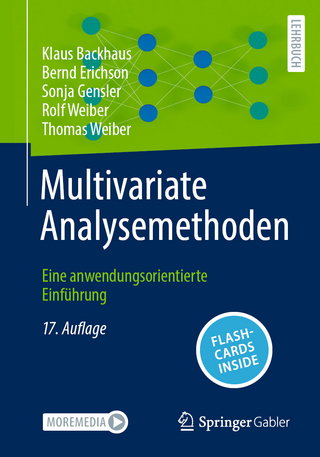
Essential Guide to Digital Signal Processing, The
Pearson (Verlag)
978-0-13-380442-3 (ISBN)
Breakthrough DSP applications: from smartphones to healthcare and beyond
Covers both digital and analog signals
An indispensable resource for tech writers, marketers, managers, and other nonengineers
The Complete DSP Guide for Businesspeople and Nontechnical Professionals
Digital signal processing (DSP) technology is everywhere–each time you use a smartphone, tablet, or computer; play an MP3; watch a digital TV or DVD; get GPS directions; play a video game; take a digital photo; or even have an MRI, DSP technology is at work.
Now, for the first time, The Essential Guide to Digital Signal Processing offers readers of all levels simple, plain-English explanations of digital and analog signals and modern DSP applications. Whether you sell technology, write about it, manage it, fix it, or invest in it, this is the book for you.
Using everyday examples and simple diagrams, two leading DSP consultants and instructors completely demystify signal processing. You’ll discover what digital signals are, how they’re generated, and how they’re changing your life.
You’ll learn all you need to know about digital signal collection, filtering, analysis, and more, and how DSP works in today’s most exciting devices and applications.
Coverage includes
How engineers understand and work with analog signal spectra and frequencies
How digital signals are generated and used in modern electronic devices
The surprising things that happen when analog signals are converted to digital form
How (and why) engineers compute digital signal spectra with Fourier transforms
What wavelets are and how they’re used everywhere, from medicine to the camera in your smartphone
How digital filters are used in DSP applications
Cutting-edge DSP applications, from automatic music-tuning software to medical EKG signal analysis
A comprehensive glossary of signal processing terminology and acronyms
You’ll gain a clear, conceptual understanding of all key signal processing operations and vocabulary. That means you’ll understand much of the “magic” built into today’s newest devices, and you’ll be ready to succeed in virtually any nontechnical role that requires DSP knowledge.
Richard G. Lyons, consulting systems engineer and lecturer with Besser Associates, received the IEEE Signal Processing Society’s 2012 Educator of the Year Award and has taught DSP at the University of California, Santa Cruz Extension. Former associate editor for IEEE Signal Processing magazine, he created and edited its “DSP Tips and Tricks” column. His books include Understanding Digital Signal Processing, Third Edition (Prentice Hall, 2011). D. Lee Fugal is president of S&ST Technical Consulting, chairman of the San Diego IEEE Signal Processing Society, and author of Conceptual Wavelets in Digital Signal Processing (Space & Signals Technical Publishing, 2009). Drawing on more than thirty years of industry experience, he teaches upper-division university courses in DSP and offers ATI short courses for working engineers throughout the United States. An IEEE Senior Member, he is a recipient of the IEEE’s Third Millennium Medal.
Preface xi
Chapter 1: What Is Digital Signal Processing? 1
The Phantom Technology 1
What Is a Signal? 2
Analog and Digital Signals 3
Digital Signal Processing 3
What You Should Remember 5
Chapter 2: Analog Signals 7
What Is an Analog Signal? 7
A Temperature Analog Signal 7
An Audio Analog Signal 8
An Electrical Analog Signal 10
A Human Speech Analog Signal 21
What You Should Remember 22
Chapter 3: Frequency and the Spectra of Analog Signals 25
Frequency 25
The Concept of Spectrum 29
Analog Signal Spectra 30
What You Should Remember 42
Chapter 4: Digital Signals and How They Are Generated 43
What Is a Digital Signal? 43
How Digital Signals Are Generated 48
The Sample Rate of a Digital Signal 52
A Speech Digital Signal 53
An Example of Digital Signal Processing 55
Another Example of Digital Signal Processing 57
Two Important Aspects of Sampling Analog Signals 61
Sample Rate Conversion 63
What You Should Remember 66
Chapter 5: Sampling and the Spectra of Digital Signals 67
Analog Signal Spectra–A Quick Review 67
How Sampling Affects the Spectra of Digital Signals 71
The Spectrum of a Digital Sine Wave Signal 82
The Spectrum of a Digital Voice Signal 85
The Spectrum of a Digital Music Signal 86
Anti-Aliasing Filters 89
Analog-to-Digital Converter Output Numbers 93
What You Should Remember 94
Chapter 6: How We Compute Digital Signal Spectra 95
Computing Digital Spectra 95
A Spectral Computation Example 97
A Spectral Analysis Example 103
What You Should Remember 106
Chapter 7: Wavelets 107
The Fast Fourier Transform (FFT)–A Quick Review 107
The Continuous Wavelet Transform (CWT) 109
What You Should Remember 117
Chapter 8: Digital Filters 119
Analog Filtering 119
Generic Filter Types 121
Digital Filtering 122
What You Should Remember 126
Chapter 9: Binary Numbers 127
Number Systems 128
Binary Data 133
Why Use Binary Numbers? 134
Binary Numbers and Analog-to-Digital Converters 136
What You Should Remember 139
Appendix A: Scientific Notation 141
Appendix B: Decibels 145
Decibels Used to Describe Sound Power Values 146
Decibels Used to Measure Earthquakes 147
Decibels Used to Describe Signal Amplitudes 149
Decibels Used to Describe Filters 153
Appendix C: AM and FM Radio Signals 155
AM Radio Signals 155
FM Radio Signals 157
Comparing AM and FM Radio 159
Appendix D: Binary Number Formats 161
Unsigned Binary Number Format 161
Sign-Magnitude Binary Number Format 162
Two’s Complement Binary Number Format 163
Offset Binary Number Format 165
Alternate Binary Number Notation 166
Glossary 169
Index 185
| Sprache | englisch |
|---|---|
| Maße | 178 x 229 mm |
| Gewicht | 330 g |
| Themenwelt | Mathematik / Informatik ► Informatik |
| Mathematik / Informatik ► Mathematik ► Finanz- / Wirtschaftsmathematik | |
| Wirtschaft ► Betriebswirtschaft / Management | |
| ISBN-10 | 0-13-380442-9 / 0133804429 |
| ISBN-13 | 978-0-13-380442-3 / 9780133804423 |
| Zustand | Neuware |
| Haben Sie eine Frage zum Produkt? |
aus dem Bereich


